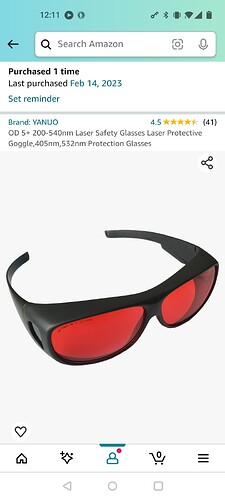I’ve been shopping for glasses for some time and I’ve studied the subject quite a lot.
The first thing is the wavelength of your laser (for higher energy lasers also for harmonics, but this is not relevant for us), that’s what the glasses need to protect. My laser works around 1080nm, yours, if I’m right 450-460nm (please check this)
So you should look for glasses to block this wavelength.
The other parameter is the blocking efficiency, better quality glasses have this value in Optical Density (OD) and a number like OD4, OD5, OD6, etc. The number shows how many zeros in the percent value they let the given wavelength light thru, like 0.00001%
You can calculate the minimum OD value you need here: Laser Institute of America - Free OD Calculator
There is no sense of just having a general OD value, it must be specified by wavelength, if there is an OD graph, it is the most convincing. The higher is the OD the better (there are glasses up to OD10+, these are quite expensive though).
Another consideration is how much light you want to see at the unprotected wavelength, the more, the better you see. and does not make you take off your glasses every moment, which is a security risk. That’s why we are looking for selective filtering, so the OD value should be as high as possible at the wavelength of your laser and - if you want more vision - as low as possible at all other wavelengths. if you’re blocking more visible light, cheaper glasses can provide just as good protection. the extreme end of this is glasses with metallic sheets they block OD1000+ for all wavelengths and cheap. 
there is a lot of information here: Home - Phillips Safety
Third, how comfortable the glasses are and how well they protect from the sides, no point if you have a good lens, but the light goes into the corner of your eye from the side, you don’t have to look into the laser to be dangerous. I 3D printed an additional sleeve around my glasses, you can’t try on glasses bought online, and they will never fit your head 100%. if you don’t buy the rubber-edged goggle type.
There may be similarly capable glasses for a good price on ebay, aliexpress, etc. but I couldn’t figure out how to filter out (Pardon the pun) the lenses that were actually tested.
Unfortunately we can’t accurately test glasses at home, there are videos on youtube of ‘testing’ glasses by letting laser beam thru them, but these ‘measurements’ don’t even come close to the required dynamic range to tell apart a e.g. 0.0001% transmittance from a 0.00001%, and all this would be required depending on the wavelength. When someone burns glasses as ‘testing’ an OD0 lens will behave exactly the same as a $800 OD10+ you need a laboratory equipped with expensive instruments to make a OD chart. And even many of these instruments not measure beyond OD6, 7… that’s why many charts are cut off at the top. But anything at or above OD6 is OK for us.
I was looking for dual purpose glasses (a have a fiber laser at 1080nm and also a CO2 laser on 10600nm) found an OD7+ for both wavelengths with good VLT (visual light transmittance) almost clear lenses (slightly blue) for €168 net. There were cheaper alternatives for either one blocked wavelength or less VLT.
